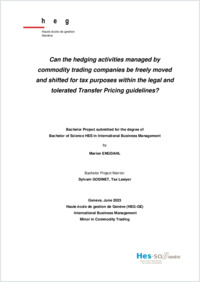Can the hedging activities managed by commodity trading companies be freely moved and shifted for tax purposes within the legal and tolerated transfer pricing guidelines ?
SONAR|HES-SO
- Engdahl, Marion
- Godinet, Sylvain (Degree supervisor)
- Genève : Haute école de gestion de Genève
99 p.
Bachelor of Sciences HES in International Business Management: Haute école de gestion de Genève, 2023
English
In a context where commodity trading companies are constantly seeking efficiency, it is worth asking whether these companies can freely move their hedging activities within the legal transfer pricing guidelines. In fact, hedging activities play a crucial role and represent a substantial source of income for these companies, whose primary focus still lies in physical commodity trading, a highly risky and unpredictable business. Additionally, the apparent lack of specific regulations that explicitly prohibit the relocation of these significant activities intensifies the interest surrounding this question.
To enhance the understanding of the existing guidelines, a thorough examination of the current transfer pricing practices and guidance provided by the Organisation for Economic Co-operation and Development (OECD) was conducted. Additionally, an in-depth analysis was carried out on the objectives and functions of hedging activities. Then, to put this literature review into perspective, transfer pricing professionals active in commodity trading were interviewed to provide valuable insights into potential obstacles faced when separating hedging from physical trading.
Several key points of reluctance therefore emerge. Firstly, traders’ desire to work in famous trading hubs supersedes organisational decisions. Secondly, accounting and risk management difficulties could arise if hedging and physical trading are not reported under the same jurisdiction. Thirdly, the significant uncertainty surrounding profit and loss allocation among entities within the same group presents challenges to the performance of each induvial entity. Lastly, the introduction of the minimum global tax rate of 15% established by the Base Erosion and Profit Shifting (BEPS) program is viewed as a looming factor, threatening the offshore relocation of hedging activities.
Although there might be operational and accounting barriers to be addressed, this pioneering research shows that commodity trading companies could overcome these obstacles and achieve an improved tax optimization through the strategic evaluation of tax regulations, the leverage of jurisdictions, and the fair utilization of tolerated tax adjustment tools while behaving transparently, ethically, in tandem with tax authorities.
Finally, the global minimum tax rate of 15% presents a significant concern for commodity trading companies, as they will not be able to circumvent its application, despite its uncertainty. However, this tax rate could potentially be beneficial for Switzerland, further solidifying its appeal from both a tax and an economic perspective.
To enhance the understanding of the existing guidelines, a thorough examination of the current transfer pricing practices and guidance provided by the Organisation for Economic Co-operation and Development (OECD) was conducted. Additionally, an in-depth analysis was carried out on the objectives and functions of hedging activities. Then, to put this literature review into perspective, transfer pricing professionals active in commodity trading were interviewed to provide valuable insights into potential obstacles faced when separating hedging from physical trading.
Several key points of reluctance therefore emerge. Firstly, traders’ desire to work in famous trading hubs supersedes organisational decisions. Secondly, accounting and risk management difficulties could arise if hedging and physical trading are not reported under the same jurisdiction. Thirdly, the significant uncertainty surrounding profit and loss allocation among entities within the same group presents challenges to the performance of each induvial entity. Lastly, the introduction of the minimum global tax rate of 15% established by the Base Erosion and Profit Shifting (BEPS) program is viewed as a looming factor, threatening the offshore relocation of hedging activities.
Although there might be operational and accounting barriers to be addressed, this pioneering research shows that commodity trading companies could overcome these obstacles and achieve an improved tax optimization through the strategic evaluation of tax regulations, the leverage of jurisdictions, and the fair utilization of tolerated tax adjustment tools while behaving transparently, ethically, in tandem with tax authorities.
Finally, the global minimum tax rate of 15% presents a significant concern for commodity trading companies, as they will not be able to circumvent its application, despite its uncertainty. However, this tax rate could potentially be beneficial for Switzerland, further solidifying its appeal from both a tax and an economic perspective.
- Language
-
- English
- Classification
- Economics
- Notes
-
- Haute école de gestion Genève
- International Business Management
- hesso:hegge
- Persistent URL
- https://folia.unifr.ch/global/documents/327664
Statistics
Document views: 58
File downloads:
- IBMBT_23_ENGDAHL_Marion_VF_archived version.pdf: 99
